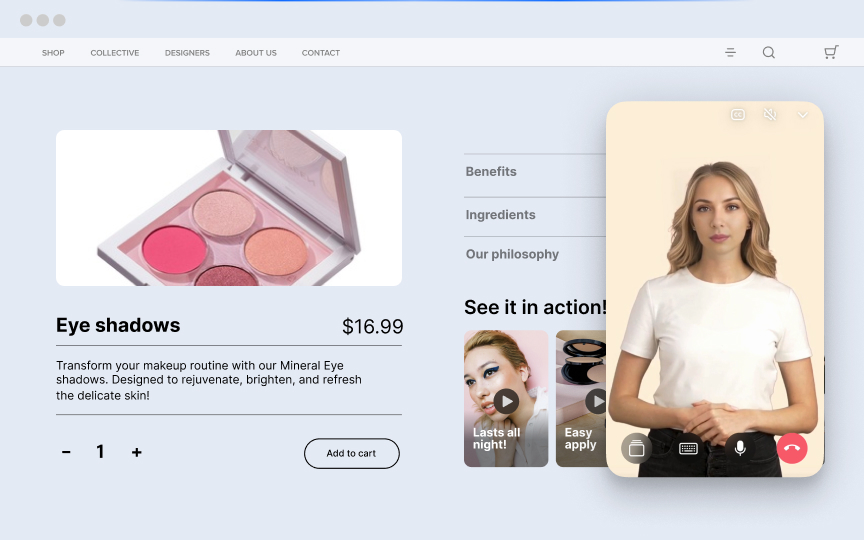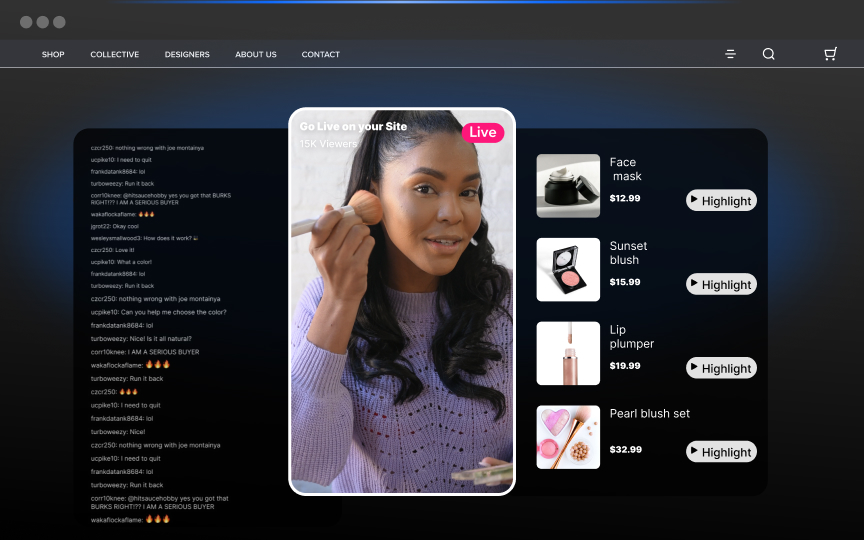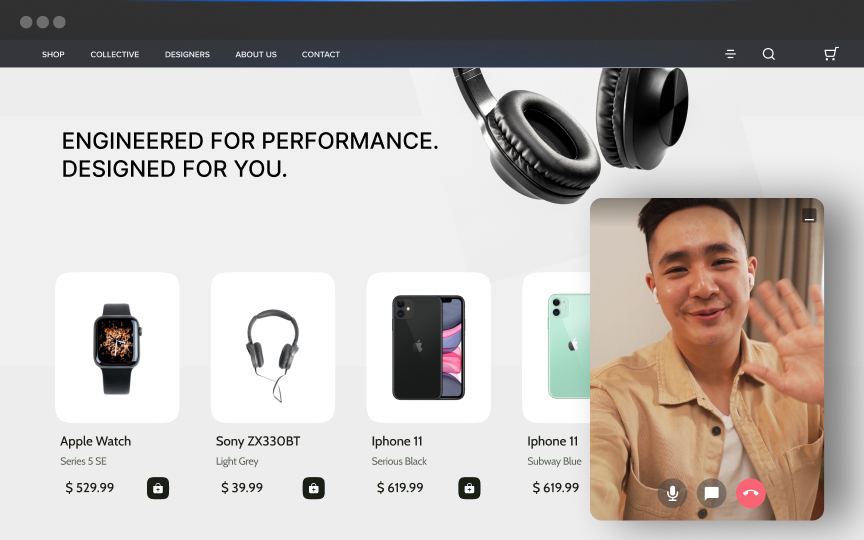In 1995, RealNetworks, an internet company, developed the first media player that was able to live stream. Since then, live streaming has been used by businesses to garner customers’ attention for a plethora of scenarios – education, entertainment, and customer interaction. However, converting this attention to actual sales has been a long-standing problem for businesses.
As the technology for live streaming has advanced, businesses have found more creative ways to reap its benefits. From live product demonstrations to virtual events, live streaming has become a powerful tool for engaging customers.One of the most exciting developments in this space is the rise of live shopping. By allowing customers to interact with products and ask questions in real-time, live shopping has the potential to drive significant sales growth.Over the years, livestream has evolved into a full-funnel customer experience powering live shopping interactions. Businesses can now directly drive sales through live streaming by providing customers with the ability to purchase products in real-time on their ecommerce store.
According to Mckinsey, live shopping sales may make up 20% of all eCommerce sales by 2026.
In this blog, we will take a look at some of the key livestream shopping trends that will unlock the growth for brands in 2023.
Livestream Shopping Trend 1:
Surge of Livestream Shopping on Brand-Owned Digital Properties
As the world becomes increasingly digitized, the number of livestream shopping platforms is rising. However, brands are beginning to realize the importance of bringing live commerce experiences to their own platforms in order to boost engagement with their target audience and conversions.On-site livestream videos make it easier for brands to accelerate conversions compared to generic videos. Hosting shoppable live shopping event on their own platforms, gives brands access to multiple data points compared to standard videos and static images.Hosting a live event on their own platforms also allows brands to fully control the shopping experience, including the ability to offer exclusive promotions, discounts, and deals.Additionally, brands can use the data collected from on-site livestream events to personalize customer experiences, including targeted product recommendations and ads.Armed with greater insight into customer intentions and activity, brands can design better customer journeys that amp up the overall experience. On-site livestream shopping events can be a powerful tool for brands to increase engagement, conversions, and customer loyalty.
Coresight predicts that the value of shoppable livestreaming in the U.S. will increase from $20 billion in 2022 to $32 billion in 2023.
A huge number of brands across industries will move beyond the two-dimensional retail experience and host livestream shopping sessions on their owned digital properties.
Example:
Fashion brand, H&M, has recently added a Livestream shopping feature to their website, allowing customers to browse and purchase items in real-time during live fashion shows.[embed]https://www.youtube.com/watch?v=gwTgoEiA2m8[/embed]
H&M hosted a livestream shopping event with Jenna Palek
Livestream Shopping Trend 2:
Greater Use of In-house Brand Advocates
2023 will see a new crop of “influencers” unleash their influence at no additional investment. The rise of Livestream shopping has brought about a new trend in retail: leveraging in-house brand advocates. Store associates are now becoming the new brand influencers, giving influencer marketing a new spin.The shift towards livestream shopping has made it easier for retailers to connect with target audience in real time, allowing them to foster trust and fast-track sales.Store associates have a deep understanding of the products they are selling, which allows them to provide detailed and accurate information to potential customers.This level of expertise and knowledge can be hard to replicate with external influencers, making them more relatable and trustworthy to potential customers.Furthermore, by giving the in store specialist more face time, retailers can create a more personal and human-centric experience for customers, which can help to build a stronger emotional connection with the brand.To capitalize on this trend, brands will be seen training and empowering their in store advisors to host one-to-one as well as one-to-many Livestream sessions.
Example:
Another example is a Japanese retail major, MUJI that regularly hosts live shopping events with store associates for product demonstrations and new launches on their website.

Muji regularly hosts livestream shopping events led by in house advisors
This not only helps their customers to learn about the products but also helps them to make more informed purchasing decisions.
Livestream Shopping Trend 3:
Personalised Shopping is Going to Be Big Across Industries
With the rise of livestream shopping, retailers across categories are starting to explore how they can use this technology to enhance the one-to-one shopping experience at scale.Essentially, livestream shopping enables brands to -1. Giving customers a chance to inspect products up close, ask questions and interact with product experts. This is akin to a real-life shopping experience that lets people immerse themselves into the shopping experience completely.2. 1-1 livestreams: an intimate, hyper-personalized experience to discerning customers where the need for such attention to detail is necessary.One category where live shopping is expanding is luxury goods. Luxury retailers are using livestream shopping to showcase their high-end products and create a more immersive, personalised shopping experience for customers.3. Human-first digital experience: Across digital stores and websites, live stream shopping will enable a strong human presence that will build a connection with shoppers, a powerful must-have in the day and age of personalization.
Example:
For example, luxury watch brand, Rolex, has started hosting live streams of their products, allowing customers to see the watches in more detail and ask questions in real-time.Another example is GameStop, a leading video game retailer, has started hosting live streams of its products, allowing customers to see the games in more detail and ask questions in real-time.The rising popularity of NFTs (non-fungible tokens) has also led to the expansion of livestream shopping. NFT marketplaces like Rarible, SuperRare, and OpenSea have started hosting live auctions, allowing customers to bid on unique, one-of-a-kind digital assets in real-time.
Livestream Shopping Trend 4:
Phygital Experiences will Transform Shopping Experiences
Phygital refers to the blending of physical and digital elements in retail to power a wholesome customer experience. Live shopping elevates the phygital experience by boosting customer engagement across physical and digital touchpoints.With the rise of livestream shopping, retailers are now able to replicate the in-store experience in the digital realm, giving customers the opportunity to interact with product experts and inspect products up close.This not only enhances customer engagement but also drives conversions across both physical and digital touchpoints.Furthermore, phygital experience leverages livestream shopping technology to create a sense of community and exclusivity among customers, building brand loyalty and driving repeat business.In 2023, retailers of all sizes will be seen reimaging customer experience by leveraging livestream shopping to bring together the human connection of in-store experience and the convenience of online shopping.Here are some of the ways in which retailers will be powering phygital experiences -1. Online to Offline: Brands will leverage live shopping to drive more footfalls to retail outlets in interesting ways such as reserve online, buy in store, or buy on online, pick up in store. Brands will also be seen handing out digital coupons to livestream viewers that can be redeemed in store2. Offline to Online: Livestream shopping campaigns at POS displays, malls, and stores on digital screens will aid product discovery and deliver on the promise of 'shoppertainment' linking back to an online shopping experience on the livestream shopping platform.
Example:
One of the world’s leading retail brands, Burberry started to use live shopping to showcase its new collections and allow customers to make purchases directly from the livestream.The brand uses a combination of live-streamed runway shows and live commerce-enabled product demonstrations to showcase its new collections. Customers can watch the live streams on Burberry's website and make purchases directly from the stream.[caption id="attachment_23551" align="aligncenter" width="964"]

Source: Burberry hosted the livestream of London Fashion Week shows on its website, allowing customers to pre-order their favourite items from the show.[/caption]With brands closing the digital-physical gap, consumers will be able to enjoy a life-like, immersive experience with real human beings on the other side of the screen, complete with interaction and community elements.
Livestream Shopping Trend 5:
Virtual Reality and Augmented Reality will Enhance Livestream Shopping Experience
Virtual reality (VR) and augmented reality (AR) technology are being used to enhance the online shopping experience, making it more interactive and immersive for customers.One way that VR and AR technology is envisioned to be used in live shopping is through the integration of dynamic trials.For example, a customer can virtually try on a piece of clothing or see how a piece of furniture would look in their home before making a purchase. This allows customers to envision the product in a simulated real world environment and make more informed purchasing decisions.Another way that VR and AR technology can be used in livestream shopping is through the use of customized filters. For example, a customer can virtually try on different makeup looks or visualise how a product would look in different colors or sizes. This allows customers to see the product in a more personalized setting and make more informed purchasing decisions.While blending AR capabilities with live shopping is something that brands are toying with, brands have already been using AR and VR to augment customers’ online shopping experiences.
Example:
Furniture giant, Ikea, has been using AR technology that allows customers to see how furniture would look in their home before making a purchase. This capability can be brought to the live shopping experience to create dynamic in-stream visualization in real-time.Sephora, one of the world's leading beauty brand, has successfully integrated augmented reality in its Virtual Assist App. The feature aways customers to test the products live and purchase directly in the app.[embed]https://www.youtube.com/watch?v=NFApcSocFDM&embeds_euri=https%3A%2F%2Fblog.adobe.com%2F&feature=emb_logo[/embed]
Sephora's Virtual Assist App enables live trials before the actual purchase
Wrap Up
Live Commerce trends will have a significant impact on retailers and customers alike. By leveraging livestream shopping trend, retailers can create a more immersive, personalised shopping experience for customers, foster trust, and fast-track sales.On the other hand, customers will benefit from the ability to interact with products and store associates in real-time, and make more informed purchasing decisions.Additionally, the use of live streaming technology will enable brands to provide a human-first digital experience, adding a strong human presence that will build a connection with shoppers. This can help to personalize the customer experience, including targeted product recommendations and ads.It is expected that a large number of brands will move beyond the two-dimensional retail experience and embrace the trend of live shopping events on their owned platforms, to stay ahead of the competition, increase customer engagement, and drive salesRetailers should start experimenting with livestream shopping and embrace these trends in 2023 to capitalize on the growth of the eCommerce industry. Would you like to explore what Firework can do for your brand? Request a demo today!
FAQs
What are the benefits of livestream shopping on brand-owned digital properties
Livestream Shopping refers to the practice of combining the convenience of online shopping with the entertainment of live streaming, where viewers can interact with hosts and purchase products in real-time. With the pandemic accelerating the shift to e-commerce, many brands are now turning to Livestream Shopping as a way to engage with customers and drive sales on their own digital properties, such as websites, and mobile apps. This surge of livestream shopping on brand-owned digital properties has become an increasingly popular marketing strategy for brands to connect with their audiences in a more interactive and engaging way.
What is the trend of using in-house brand advocates and why is it becoming more prevalent?
Answer: The trend of using in-house brand advocates is growing as companies realize the benefits of having passionate employees promote their brand. In-house brand advocates are employees who are enthusiastic about their company and its products or services, and actively promote it on social media or other channels. By leveraging these advocates, companies can amplify their brand messaging and reach a wider audience. Additionally, in-house advocates can provide a more authentic voice and help to establish trust with consumers. This approach can be more cost-effective than traditional advertising or collaborating with influencers, and also helps to foster a sense of community and loyalty among employees.
How will phygital experiences transform shopping experiences?
With the rise of e-commerce, physical retail stores have been struggling to keep up. However, the integration of technology and physical spaces has resulted in the emergence of phygital experiences. These experiences blend the physical and digital worlds to create immersive and engaging experiences for customers. By using technologies such as augmented reality, virtual reality, and interactive displays, retailers can create unique experiences that differentiate their brand and increase customer engagement. Phygital experiences have the potential to transform the shopping experience by providing customers with the convenience of online shopping and the tactile experience of physical stores.
Unlock Exclusive Insights
By submitting this form, you agree to Firework's privacy policy and consent to receive personalized marketing communications. You can unsubscribe at any time.
































